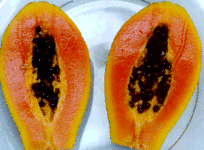Papaya - pawpaw
Introduction
The papaya Carica papaya is thought to be indigenous to
the West Indies and northern South America. It was carried by the
Spanish to Manila in the mid 1500's. From there it went to
Malacca then India and reached Hawaii in 1800-1820's.
There are 45 species of papaya and the "trees" reach fruit
bearing age after only a year, so are very fast growing; see the
getJamaica web site or the California Rare Fruit
Growers site for more details.
The "Solo" type, with pink flesh was introduced to Hawaii from
Barbados and Jamaica in 1911.
Papaya is currently cultivated on 800 acres of land located
mainly in St. Thomas and Trelawny. There are 8 main papaya
growers and together they employ a labour force of approximately
600 persons.
Jamaica exports the "sunrise" variety which has a deep red flesh.
Exports from Jamaica began in the 80's, 4062 tonnes were shipped
in 1995, 4704 tonnes in 1996 and 4001 tonnes in 1998. The
breakdown on exports at that time was 53% of the fruit was
destined for the US market, 25% for the UK, 17% for Canada and 5%
for Holland.
A typical arrangement for the orchards would be that the trees
are planted in a free-draining soil with a plant population of
792 to the acre and a spacing of 3 by 1.5 metres. The expected
yield is 100 to 140 export boxes per acre per week with each box
containing 4 kg of fruit.
Visit the Jamaica Papaya
Growers Association pages from more information.
Chemistry
Sugars
Much of the early work on the estimation of sugars in papaya is
now known to be incorrect due to the presence of an invertase
enzyme. A more recent evaluation which heated the samples in a
microwave oven to deactivate the enzyme has given the
distribution as follows:
sucrose (48.3% early reports suggested NONE), glucose (29.8%) and
fructose (21.9%).
The total carbohydrate content has been found to be around 10
g per 100 g of edible portion.
Acids
The acid content of papayas is very low and the pH is generally
between 5.5 - 5.9 and comes from almost equal amounts of citric
and malic acid.
Pigments
The difference between yellow and red-fleshed papayas was first
described in 1964 and the total carotenoid content was reported
to be 3.7 mg/100 g and 4.2 mg/100 g respectively.
The major differences can be seen in the following table.
| Percent composition of carotenoid pigments |
| pigment |
yellow |
red |
| beta-carotene |
4.8 |
4.8 |
| zeta-carotene |
24.8 |
5.9 |
cryptoxanthin
and monoepoxide |
15.6 |
4.4 |
| cryptoxanthin |
38.9 |
19.2 |
| lycopene |
0.0 |
63.5 |
| unresolved |
15.9 |
2.2 |
The structure of lycopene is given below:
Check this out for reasons to eat the red papaya with lots of lycopene!
Volatiles
106 volatile compounds were identified in 1977 using GC/MS
techniques. The compound thought to have the odour that most
closely resembled that of papayas was
linalool - 68%.
Benzyl isothiocyanate - 13% contributes a pungent off-odour
and is present as a major component.
Papain and other enzymes
Several enzymes have been found in papayas of which papain is of
commercial importance. 2/3 of the usage in the USA is as a meat
tenderiser and it is used as a beer stabilising agent as well.
Papain is recovered by making scratches (tappings) in the latex.
6 tappings over 15 days has been recommended for optimum recovery
of the enzyme. The scratches are made 0.2 cm deep at 1.25 cm
apart and are best done on days 1,3,6,9,12 and 16. The yield is
of the order of 180 lb per acre. The latex is either
hyperallergenic or an irritant and so it is necessary to wear
gloves. The scratches should not be made with a metallic knife
although collection into aluminum trays is found to be OK.
Processing by 95% alcohol followed by acetone gives complete
precipitation and dehydration. The 212 amino acid sequence has been
determined.
References
"Tropical Fruit Processing", Edited by J. Jagtiani, H.T. Chan,
Jr. and W.S. Sakai Food Science and Technology, A series of
monographs, 1988, Academic Press, Inc., 1250 Sixth Avenue, San
Diego, California, 92101.
"Food Flavourings", Edited by P.R. Ashurst, Blackie Academic
& Professional, an imprint of Chapman & Hall, Wester
Cleddens Road, Bishopbriggs, Glascow, G64 2NZ, UK. 2nd edit.
1995.
The Jamaica Gleaner, Farmers Weekly, Sat 14th June-97, page A 11.
Return to links to the chemistry of other
Jamaican items, including spices and fruit and vegetables.
 Return to Chemistry, UWI-Mona,
Home Page
Return to Chemistry, UWI-Mona,
Home Page
Copyright © 1997-2014 by Robert John
Lancashire, all rights reserved.
Created and maintained by Prof. Robert J.
Lancashire,
The Department of Chemistry, University of the West Indies,
Mona Campus, Kingston 7, Jamaica.
Created May 1997. Links checked and/or last
modified 8th August 2014.
URL
http://wwwchem.uwimona.edu.jm/lectures/papaya.html


 Return to Chemistry, UWI-Mona,
Home Page
Return to Chemistry, UWI-Mona,
Home Page